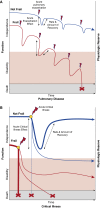Frailty in Pulmonary and Critical Care Medicine
- PMID: 27104873
- PMCID: PMC5021078
- DOI: 10.1513/AnnalsATS.201512-833FR
Frailty in Pulmonary and Critical Care Medicine
Abstract
Conceptualized first in the field of geriatrics, frailty is a syndrome characterized by a generalized vulnerability to stressors resulting from an accumulation of physiologic deficits across multiple interrelated systems. This accumulation of deficits results in poorer functional status and disability. Frailty is a "state of risk" for subsequent disproportionate declines in health status following new exposure to a physiologic stressor. Two predominant models have emerged to operationalize the measurement of frailty. The phenotype model defines frailty as a distinct clinical syndrome that includes conceptual domains such as strength, activity, wasting, and mobility. The cumulative deficit model defines frailty by enumerating the number of age-related things wrong with a person. The biological pathways driving frailty include chronic systemic inflammation, sarcopenia, and neuroendocrine dysregulation, among others. In adults with chronic lung disease, frailty is independently associated with more frequent exacerbations of lung disease, all-cause hospitalization, declines in functional status, and all-cause mortality. In addition, frail adults who become critically ill are more likely develop chronic critical illness or severe disability and have higher in-hospital and long-term mortality rates. The evaluation of frailty appears to provide important prognostic information above and beyond routinely collected measures in adults with chronic lung disease and the critically ill. The study of frailty in these populations, however, requires multipronged efforts aimed at refining clinical assessments, understanding the mechanisms, and developing therapeutic interventions.
Keywords: body composition; disability; frailty; health-related quality of life; mortality.
Figures


References
-
- Cowdry EV. Problems of ageing: biological and medical aspects. 2nd ed. Baltimore: Williams and Wilkins; 1942.
-
- Fried LP, Tangen CM, Walston J, Newman AB, Hirsch C, Gottdiener J, Seeman T, Tracy R, Kop WJ, Burke G, et al. Cardiovascular Health Study Collaborative Research Group. Frailty in older adults: evidence for a phenotype. J Gerontol A Biol Sci Med Sci. 2001;56:M146–M156. - PubMed
Publication types
MeSH terms
Grants and funding
LinkOut - more resources
Full Text Sources
Other Literature Sources
Medical

